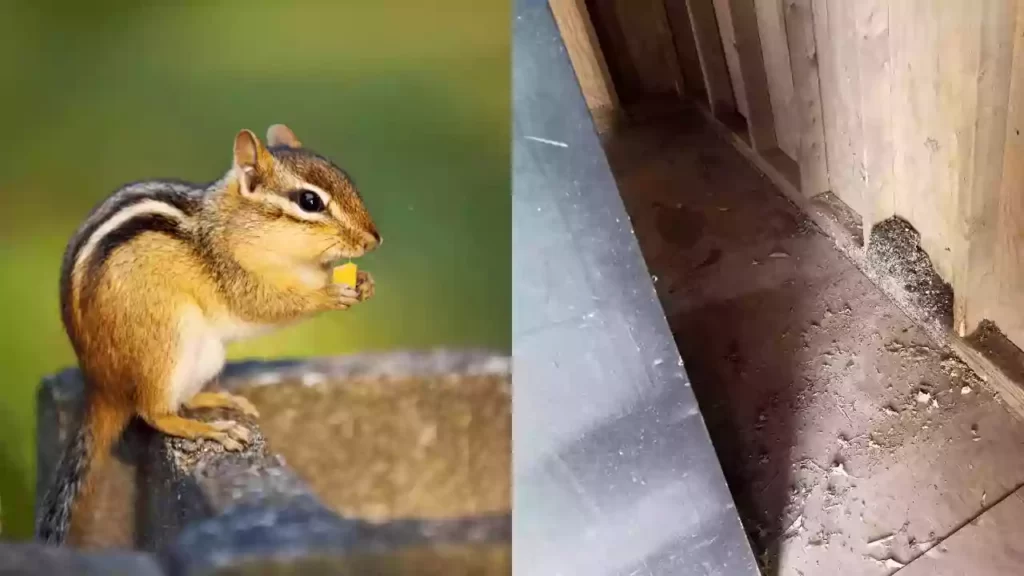Have you ever seen a chipmunk dying? But how to tell if a chipmunk is dying?
Chipmunk breathing but not moving or chipmunk eyes closed? Well, the most common signs of a dying chipmunk are wounds, visible tumors, shivering, or blood flowing from the chipmunk’s body.
Chipmunks are adorable, fluffy, round animals having a height of around 6-7 inches and weighing nearly 3 ounces. They belong to the cute rodent category, but they can turn out quite destructive. No matter what, you are surely going to witness this rodent in your backyard.
Out of the many situations, one can be of seeing a dying chipmunk. Please read below to find out more signs and ways to help them out.
How To Tell If A Chipmunk Is Dying?

There are many ways to tell if a chipmunk is dying, but the most apparent ones include notable signs of blood or wounds. They might look fluffy or dizzy if you try to walk them. Look out for glue, strings, or oil on their body or some other apparent injuries. The chipmunk may move around in a circle or lose balance and trip while trying to move.
Signs Of A Dying Chipmunk
If you want to tell if a chipmunk is dying, you can identify this quickly. The chipmunk is breathing but not moving, or the chipmunk has its eyes closed. Besides these two signs, there are many others like:
- having seizures or spasms
- discharge from mouth, nose, ears, or eyes
- shivering, coughing, sneezing, or wheezing
- wounds, cuts, or rashes
- dizzy, or sedentary behavior
- noticeable tumors
- passing blood, pus, or diarrhoea
- severe injury due to animal attacks or a road accident
Baby Chipmunk Sound
Chipmunk Care: How To Save A Dying Chipmunk In 2 Steps?
If the chipmunk is dying of starvation, try to rehydrate the dying chipmunk with a hydrating solution. Warm the solution and then feed it to the dying chipmunk. You can use a syringe or dropper for this purpose. Initially, do this every couple of hours, and then you can repeat the procedure every 12 hours.
If the dying chipmunk is severely injured, you can save him by contacting your local wildlife department. Mention the condition and follow the guidance they give you accurately. Stick to their advice till the time they arrive with their safety protocol.
In the meantime, cover the injured animal with a soft cloth or towel, and place it in a container. Try to keep the animal warm and calm.
How To Save A Chipmunk In Shock? 8 Steps

Chipmunks go into shock for several reasons. Commonly it is due to some internal trauma or blood loss due to a car accident or if another animal bites them.
Chipmunks can also go into shock due to excessive fluid loss from diarrhea or vomiting, airways obstruction caused by choking, or respiratory illness like pneumonia.
Shock cannot be taken lightly as it is the number 1 killer in animals. The chipmunk’s body compensates for the lost blood by speeding up the heartbeat to keep up with the falling blood pressure. Simultaneously there is also a load on the blood vessels to supply sufficient blood to the vital organs of the chipmunk’s body.
But suppose the chipmunk is bleeding heavily from serious injury. In that case, its body will overreact and cause a pooling of blood in the internal organs. This will cause a significant drop in the blood pressure and oxygen starvation of the brain leading to death.
Visible shock signs include pale white gums, rapid breathing, a weak heartbeat, and below-average body temperature (cold body). If the chipmunk is in shock, follow the steps given below to revive the animal.
Step 1: Inspect the chipmunk for shock.
Step 2: Inspect the chipmunk’s gums by lifting its upper lip. The gums will become visible. If they are pale white, this indicates the chipmunk is in deep shock and may have sustained severe injuries or bleeding. If the gums are pink, the chipmunk is probably not in shock.
Step 3: Determine the chipmunk’s heartbeat. Place your fingers firmly on the center of the animal’s chest about 2 inches behind his elbow. Count the number of beats in 10 seconds and multiply that by 6. If the chipmunk is in shock, his heartbeat will exceed 150 beats per minute.
Step 4: Place the chipmunk on its side with its head extended. Gently pull its tongue outside to keep the airway open and unobstructed.
Step 5: Elevate the chipmunk’s lower body. This can be done by placing rolled towels or small pieces of cloth under its body.
Step 6: Try to stop any signs of visible bleeding. Suppose the blood is continuously spurting and the wound is in the lower parts of the body. In that case, you will have to transport the chipmunk immediately to the vet.
Step 7: Cover it with a sterile cloth or sanitary napkin if the wound isn’t a major one. Place your hand over the dressing firmly to stop the bleeding. If the dressing is soaked in blood, don’t remove it, but apply more dressing and keep applying pressure to stop the bleeding. If the bleeding doesn’t stop even after 5 minutes, transport the chipmunk to the vet while consistently applying firm pressure on the wound.
Step 8: To conserve body heat, wrap the chipmunk in a small jacket or blanket.
How To Revive A Dead Baby Chipmunk?
The best way to revive a dead chipmunk is to seek professional veterinary assistance. Still, when no help is available, dead baby chipmunks can be revived using CPR.
Cradle the chipmunk in a towel and squeeze its chest for 5 to 10 minutes until it begins to cough up. The main goal of CPR is to press the heart long enough to get the blood flowing and keep the oxygen flowing to the lungs.
What Things Can Cause A Chipmunk To Die?
- Internal organ rupture: this can cause rapid bleeding causing the chipmunk to die.
- Garden pesticides: chipmunks may die of common deadly garden pesticides intended for other rodents.
How To Tell If A Baby Chipmunk Is Dehydrated?
Baby chipmunks will most likely become dehydrated in the early days of their life if not cared for properly. You can help them get comfortable, but before that, you need to rehydrate them. Your baby chipmunk will not be able to digest his food properly if you skip this step.
Gently pinch the baby chipmunk’s skin and see if it remains tented or immediately return to its normal position. If the skin instantly flattens out, your chipmunk is only slightly dehydrated. Suppose the skin remains tented for an extended period. In that case, the baby is severely dry and needs to be cared for with extreme caution. Pedialyte is the best rehydrating solution.
- Fill a one cc syringe with Pedialyte
- Administer it to your baby chipmunk after every two hours
- If your chip is slightly dehydrated, you should feed them Pedialyte every 6 hours
- For acute dehydration, he will need to be rehydrated for at least 12 hours
- Hold the baby chipmunk in your hand and feed him Pedialyte fluid till he willingly takes it. Don’t overfeed him. Continue till his belly is round and full but not bloated
- If the baby drinks well, repeat the process as required for the designated amount of time.
- If the baby refuses to take the liquid, don’t discontinue treatment and repeat the process every 30 minutes.
How To Help Prevent Sickness In Pet Chipmunks?
- Your pets should only be given medicines prescribed by their vet. Human or other animal medicines should never be administered as this may cause more harm than good.
- Your chipmunks should be kept away from poisonous materials like chemicals, pesticides, other plants, and toxic food.
- You, as a pet chipmunk owner, should be familiar with signs and symptoms of common ailments like ringworms, parasites, stress, dental disorders, and respiratory infections. Whenever you recognize the symptoms, contact your vet for timely assistance.
- Provide your baby chipmunk with suitable gnawing material like cuttlefish bones to tame their ever-growing teeth. Their teeth should be checked weekly for any signs of overgrowth or misalignment. Any abnormality should only be fixed by the vet.
Healthy Baby Chipmunk Signs
By regularly observing your baby chipmunk, you can make sure they are well and protected from pain. But if they start acting differently, this can be an early indication of illness.
Healthy baby chipmunks are lively, with glossy coats and bright eyes. They have no signs of diarrhea poop around their tail.
Do Chipmunks Play Dead?
If a chipmunk breathing but not moving, chipmunk eyes are closed; this is a strong indication they are playing dead. Chipmunks are intelligent and intelligent animals that can sense danger from even a great distance. They can play through, climb curtains, jump windows, and are also fast runners.
Chipmunks play dead to trick their enemies. The process of playing dead is called thanatosis. They do this to dodge the predator and watch for any potential movement from them.
Final Words
Chipmunks are fun-loving, hyperactive creatures who can serve as good pets. If this doesn’t fancy you, you can enjoy their company in the wild. Whatever the case, if you don’t intend to harm them, they will provide you good companionship.
SmallPetsX.Com does not provide veterinary advice. Our aim to help small pet owners understand their pets a little better so that they can provide their pets with the life they deserve. All content is therefore for informational purposes only. If you're concerned about the health of your pet you should seek medical advice from a vet.




